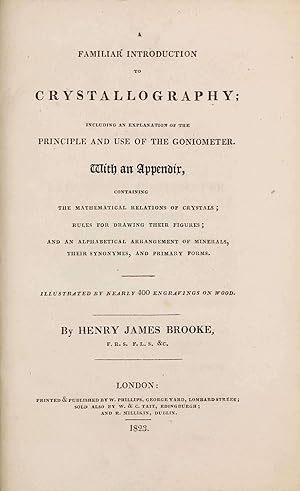About this Item
4to (205 x 130 mm). xv [1], 508 pp. Illustrated with 391 intertextual woodcut diagrams, mainly of crystal structurs, throughout. Original drab boards, spine with original printed paper label (spine chipped with loss, upper joint cracked but holding, extremities rubbed, corners scuffed). All pages uncut and partly unopened. Text only very little browned, occasional minor spotting. A fine, unsophisticated copy in original binding. [Joined:] BROOKE, Henry James. Crystallography, pp. 425-464, 5 engraved plates of crystal structures; Mineralogy, pp. 465-528. Extract from: Encyclopaedia Metropolitana; Or, Universal Dictionary of Knowledge, Volume 6 (Edward Smedley, Hugh James Rose, Henry John Rose, editors), London, 1845. Contemporary half leather, spine titled in gilt (spine and extremities heavily rubbed, corners scuffed). Binding weak, one gathering partly detached. Pasted onto flyleaf is a two-pages autograph letter signed by H.J. Brooke, dated 27 July 1833, saying he is too unwell to look through Mr Sander's papers and has anyway requested a copy of a scientific article on crystals. ---- RARE FIRST EDITION. "Dedicated to William Wollaston, inventor of the reflecting goniometer, this book proposes a new system of crystallographic notation. Brooke uses a method of letters and subscript figures to indicate crystal forms. For the primary forms or primitive, he chose the capitals P, M, T (from primitive). Secondary and other faces were noted with other letters in small type. Sweet (1978) suggests that this particular nomenclature was developed by Brooke from Count Bournon's treatise on calcite, which allocated numbers to each form found. This work had great influence on the course of crystallography during its time." (C. Schuh, Bibliography of Mineralogy, The Mineralogical Record online resource). Henry James Brooke (1771-1857) studied for the bar, but went into business in the Spanish wool trade, South American mining companies, and the London Life Assurance Association successively. His hobbies were mineralogy, geology, and botany. His large collections of shells and of minerals were presented to the University of Cambridge, while a portion of his collection of engravings was given by him to the British Museum. He was elected a Fellow of the Geological Society in 1815, Fellow of the Linnean Society in 1818, Fellow of the Royal Society in 1819, and a Foreign Honorary Member of the American Academy of Arts and Sciences in 1825. He discovered thirteen new mineral species. Brooke published a Familiar Introduction to Crystallography, London, 1823; and contributed the articles on "Crystallography" and "Mineralogy" in the Encyclopędia Metropolitana, in which he first introduced six primary crystalline systems. (Wikisource). - Visit our website for additional images and information. Seller Inventory # 003148
Contact seller
Report this item
![]()




